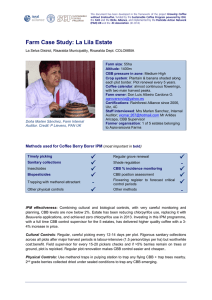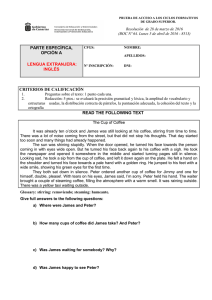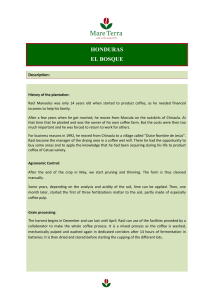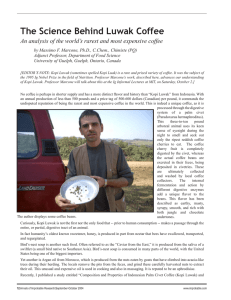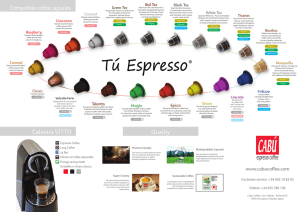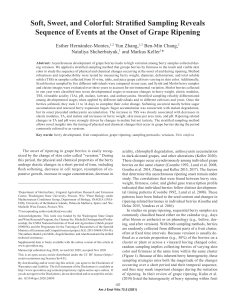Belmont Estate - 4C Association
Anuncio
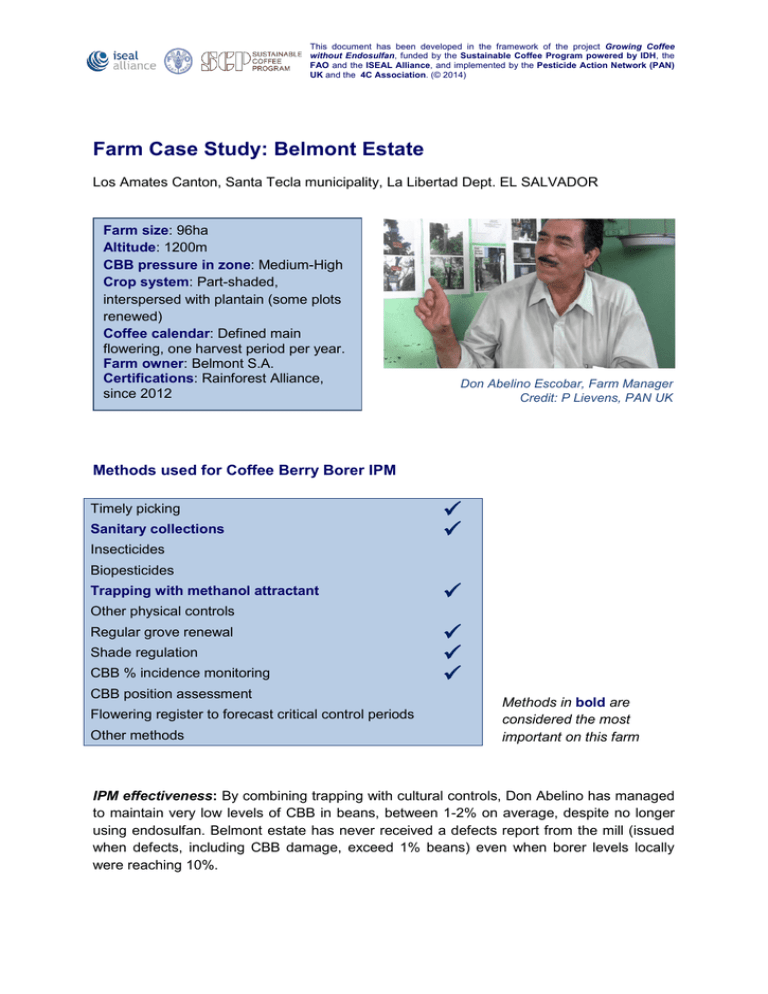
This document has been developed in the framework of the project Growing Coffee without Endosulfan, funded by the Sustainable Coffee Program powered by IDH, the FAO and the ISEAL Alliance, and implemented by the Pesticide Action Network (PAN) UK and the 4C Association. (© 2014) Farm Case Study: Belmont Estate Los Amates Canton, Santa Tecla municipality, La Libertad Dept. EL SALVADOR Farm size: 96ha Altitude: 1200m CBB pressure in zone: Medium-High Crop system: Part-shaded, interspersed with plantain (some plots renewed) Coffee calendar: Defined main flowering, one harvest period per year. Farm owner: Belmont S.A. Certifications: Rainforest Alliance, since 2012 Don Abelino Escobar, Farm Manager Credit: P Lievens, PAN UK Methods used for Coffee Berry Borer IPM Timely picking Sanitary collections Insecticides Biopesticides Trapping with methanol attractant Other physical controls Regular grove renewal Shade regulation CBB % incidence monitoring CBB position assessment Flowering register to forecast critical control periods Other methods Methods in bold are considered the most important on this farm IPM effectiveness: By combining trapping with cultural controls, Don Abelino has managed to maintain very low levels of CBB in beans, between 1-2% on average, despite no longer using endosulfan. Belmont estate has never received a defects report from the mill (issued when defects, including CBB damage, exceed 1% beans) even when borer levels locally were reaching 10%. Background: In this zone, borer levels can easily reach 9-10% if CBB management is poor. Many large estates with highly technified groves have relied for years on spraying endosulfan two or three times per season, often without sampling to see if borer levels have exceeded the recommended decision threshold of 5%. For some farmers, it’s almost a custom that they spray in May or June, regardless of borer levels. Endosulfan remains the main control method for CBB in El Salvador’s coffee production, although the government recently announced plans to ban it. Don Abelino manages Belmont estate, one of over 2,200 large and medium farms selling to coffee export company COEX. The company, along with around 50 of its suppliers which produce speciality or coffee certified under sustainability standards, faced major challenges in 2011 when Rainforest and Utz standards prohibited use of endosulfan. Starting with COEX own estates, company agronomists sought help from the national coffee research institute PROCAFE on effective methods for CBB control, which they could also roll out quickly to their certified suppliers. PROCAFE’s IPM strategy promotes: use of improved cultural controls; CBB monitoring; application of Beauveria biopesticide (produced in their own semi-commercial lab); and use of traps with methanol-ethanol attractant. Researchers had collaborated for some years with French research institute CIRAD on trialling and refining trapping methods to suit Salvadoran conditions. Don Abelino formerly applied endosulfan twice a year in plots which needed control, based on his regular sampling. He recounts that endosulfan could be very effective, however, if it rained shortly after application, he would need to spray again, at further cost. At other times, an application would simply fail to control the pest and levels would rise to 7-8%, requiring yet more spraying. Since COEX agronomists introduced him to trapping as an alternative, he has been delighted with the results, stopped all endosulfan use and succeeded in gaining Rainforest certification for the estate. Furthermore, he no longer risks his workers suffering ill health from pesticide poisoning and is not contaminating the environment with powerful chemicals. Cultural Controls: Don Abelino usually organises just one round of pre-harvest sanitary berry removal (‘graniteo’) per season, if any early flowerings produce significant numbers of early ripening berries. He pays for graniteo collection at daily wage rate, rather than volume, to collect small quantities (20-30kg) of early berries (ripe ones and any green that are bored). He doesn’t see the labour cost involved as a concern. In the 2013 season no graniteo picking was needed due to heavy attacks of coffee rust in 2012. On those trees that lost their leaves due to this disease, berries didn’t develop properly and on others there was no early flowering the following season so berry ripening has been very uniform. For post-harvest clean-up of groves (‘pepena’ collection), he prefers to buy back berries collected by workers and some local people. Likewise for the last harvesting round, of second grade berries, he feels it’s better to buy these back, rather than pay workers to collect them as they will always leave some in the plot. Buying the berries encourages people to collect many more and the farm benefits (a) from getting rid of CBB from the groves and (b) obtaining more coffee to sell. Physical Controls: Berries collected in graniteo picking are put in boiling water to kill CBB. Don Abelino says it is too risky just to bury these berries without this treatment. Trapping: Trap type: Don Abelino uses home-made traps made from empty drinks bottles with 2 windows cut in the sides, with dispensers of methanol-ethanol mix supplied by COEX. Dose: 2cc attractant in each dispenser. He advises you can use 1 litre, 2 or 3 litre bottles, (the size doesn’t matter) but less than 1 litre is too small to suspend the dispenser properly. He uses the same traps the following year. Density: He placed around 1,200 traps in 2013, equating to 17-20 traps per ha. Positioning: Across all plots except those recently renovated. Hang at 90100cm height irrespective of Don Abelino, Farm Manager, with one of his home-made traps, showing the methanol:ethanol dispenser. Credit: P Lievens, tree height. He increases PAN UK density near neighbours’ uncontrolled plots and where sampling reveals hotspots. Sometimes changes trap position to different trees halfway through dry season. Timing of trap placement: February to June. In later part of this period he will move traps to hotspots identified by sampling developing berries. Cost of traps and attractant: US$10.20-12.00 per ha for attractant [using PROCAFE costs of US$0.60 per methanol dispenser]. Obtains bottles for free, collected from seasonal workers and from collection bins the estate has placed outside local village stores. Maintenance: Check every 2-3 weeks, cleaning out trap water and refilling dispenser if necessary. 2cc of methanol lasts around 3 weeks. Pour ‘soup’ of dead CBB from each trap into a bucket and then bury this waste to avoid any dispersal of possible live insects. Labour requirements: Workers can easily make 150-200 traps in a day, using a penknife to cut the windows, a hot wire to make holes to thread the wire hanger through and putting the dispenser in. Two men can put out 150-200 traps in a day, covering 7-10.5ha. Comparison with insecticides: Very easy, very cheap and very effective. Approximate costs per ha for trapping: US$10-12 in traps with attractant + US$2 in labour for preparing and placing traps, totalling US$12-14 [+ maintenance labour]. Endosulfan application needs at least 700cc per 200 litre barrel, at cost of US$9-10 per litre. Labour required is 2 men for 2 days each to spray one barrel or 1.5 barrels for older trees (approx. 2 barrels per ha). For standard 2 applications per year, endosulfan spraying costs US$8.94-13.41 in product and at least US$25.56 in labour, totalling US$70-76 (+ diesel if motorised). Don Abelino reports excellent results with trapping, millions of CBB captured and he has not needed to apply any endosulfan since using the traps. Using traps and cultural controls has also reduced CBB incidence on the estate, which used to be quite high (some plots at 1540%) even when they were applying endosulfan. He emphasises that two men can prepare and hang out 200 traps, for around 10 ha in 2 days, whereas spraying endosulfan they would only cover 0.7ha in the same number of days. Trapping is much more economical for the farm and less labour-intensive than spraying. They’ve made considerable savings in control costs. Monitoring and Decision-making: Don Abelino samples each plot to assess % CBB levels once or twice per season. In plots with higher incidence, he will increase the number of traps. Biopesticide Use: None. Insecticide Use: None applied in last two years for CBB control since using traps. Recommendations Using traps is cheaper, easier and far less dangerous than using chemicals. For workers, it’s much easier to put a little water in the traps than having to carry a heavy knapsack or motorised sprayer. People can get splashed handling endosulfan solution and his workers used to almost collapse with suffocation wearing all the protective kit. With traps you don’t need any special clothing or kit, the workers just walk round placing traps in suitable positions. “On this farm we respect the environment and protect our flora and fauna”, Belmont estate pulping station. Credit: P Lievens, PAN UK You can start with fewer traps to learn the method and see for yourself that it works. He started with 500 traps in the first dry season and got good results, so he’s increased numbers this year. He’s found the more traps the better – especially in hotspots and to protect plots next to neighbouring farms where they’re not controlling CBB. Trapping is a much more certain method than insecticides - you don’t need to worry about poisoning risk or whether your spray application has worked or not. With traps, when it rains, you don’t risk losing control or needing to repeat an application. He advises not to put more than 2cc methanol in each dispenser because of issues with alcoholics who may search for full dispensers to drink. He’s not had any problem with these small quantities per trap. Try it out for yourself, whatever your farm size! You’ll find it’s easier, cheaper and less dangerous than using harmful chemicals. Support organisation contacts COEX (Comercial Exportadora S.A.de C.V.) www.grupocoex.com René Fontan, Head Agronomist, email: [email protected] See also the detailed cost comparison of trapping versus endosulfan use on COEX own estates, presented by René Fontan at the Growing Coffee without Endosulfan lesson-learning workshop, via the project webpages at http://www.4ccoffeeassociation.org/uploads/media/5_CoEx.pdf PROCAFE www.procafe.com.sv Dr Adan Hernandez, Technical Researcher, CBB IPM programme, email: [email protected]
